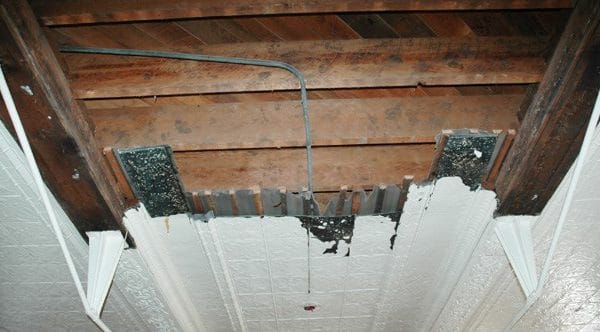Recreating an Old Ceiling: Steps to Transform Your Space
Is your ceiling in need of a makeover? Whether it’s due to water damage, cracks caused by nearby construction, or simply a desire for a fresh look, recreating an old ceiling can breathe new life into your living space. In this article, we’ll explore the steps to play an old roof, helping you make the right choices for your ceiling renovation project.
Step 1: Repairing the Texture: Recreating An Old Ceiling
Repairing the existing texture patches on your ceiling can be an excellent option under specific circumstances. This approach is most suitable when:
- The ceiling texture has never been painted before.
- The damage to your ceiling, such as water leaks or cracks, is minor.
- The damaged areas are not in areas with intense lighting, where ceiling repairs must be a near-perfect match.
- You’re working within a budget that can’t accommodate a complete ceiling overhaul, and a 95% or greater match is acceptable.
Repairing the texture involves fixing the damaged areas, ensuring they blend seamlessly with the rest of the ceiling. This option is a cost-effective choice when the damage is relatively minor and doesn’t require extensive renovations.
Step 2: Scraping and Applying New Texture
If your ceiling renovation project requires a bit more than minor repairs, scraping down the old texture and applying a fresh texture finish might be the best solution. Consider this option when:
- Your ceiling intersects with cabinets that extend all the way to the ceiling, and you prefer to keep the cabinets during the renovation.
- Your room has a low ceiling (8 feet or lower) that you don’t want to reduce in height.
- Crown molding is in place, and you wish to preserve it without covering it with new drywall.
- Bead edges intersect with the ceiling, and you’d rather avoid removing them, installing new boards, and adding new bead corners.
- The walls have been recently painted, and you prefer not to repaint them.
- Minimal drywall patches are needed due to lighting changes.
Scraping the old texture and applying a new one allows you to revitalize your ceiling without major structural changes. It’s a practical choice when you need a significant update but want to avoid undergoing a complete ceiling overhaul.
Step 3: Removing and Installing New Drywall
In cases where the lighting changes in your space are extensive, leading to substantial drywall patching, you might opt for a more comprehensive approach. Removing the old ceiling and installing new drywall is a good option. Consider this when:
- The changes in lighting necessitate extensive drywall patching, but you still prefer to preserve the overall ceiling structure.
- You’re concerned about the ceiling’s condition, and there may be asbestos in the original joint compound or texture. Asbestos was used in some cases as recently as the mid-1980s.
With this option, you can remove the old ceiling to within 6 inches of cabinets or bead edges, install new drywall, finish the joints, and apply your chosen texture. It’s a more thorough renovation method that ensures your ceiling is up to modern standards.
Step 4: Installing a Second Layer of Drywall
For those who want to avoid disturbing the insulation and vapor barrier of the attic or have concerns about asbestos, installing a second layer of drywall is a preferred option. This method is suitable when:
- Your ceiling is on the top floor, and you don’t want to disrupt the blow-fill and vapor barrier of the attic.
- Your home is older, and you suspect there may be asbestos in the original joint compound or texture.
By adding a second layer of drywall on top of the existing one, you can efficiently renew your ceiling. Finish the drywall joints, apply the texture of your choice, and enjoy a refreshed ceiling without the need for a full demolition.
Expert Tips for a Successful Ceiling Recreation Project
Recreating an old ceiling is a significant home improvement project that requires careful planning and execution. To ensure the success of your ceiling recreation, consider these expert tips:
-
Evaluate the Extent of Damage: Recreating An Old Ceiling
Before deciding on the best approach to recreating your old ceiling, thoroughly assess the damage. Determine whether the damage is minor, such as small cracks or water stains, or if it’s more extensive, like widespread water damage or structural issues. Understanding the extent of the damage will help you choose the most suitable renovation method.
-
Set a Realistic Budget: Recreating An Old Ceiling
Ceiling recreation projects can vary significantly in cost depending on the chosen method and the scale of the renovation. Set a realistic budget for your project and consider factors such as materials, labor, and any unexpected expenses that may arise during the renovation. Having a clear budget will help you make informed decisions throughout the process.
-
Choose the Right Texture: Recreating An Old Ceiling
If you opt for repairing or applying a new texture to your ceiling, carefully select the texture that complements your overall interior design. Popular ceiling textures include popcorn, knockdown, and orange peel. Your choice of texture can impact the aesthetics of the entire room, so take your time to decide on the best fit.
-
Consider Lighting Design: Recreating An Old Ceiling
Lighting plays a crucial role in how your ceiling looks and feels. If you’re making changes to your lighting fixtures as part of the renovation, consider the placement and type of lighting you want. Well-placed lighting can highlight the texture and design of your ceiling, creating a more visually appealing space.
-
Hire a Professional Contractor: Recreating An Old Ceiling
While some ceiling recreation projects may be suitable for DIY enthusiasts, others require professional expertise. If your project involves extensive structural changes or if you need clarification on handling the renovation yourself, it’s wise to hire a qualified contractor. They can provide guidance, ensure safety, and deliver high-quality results.
-
Properly Prepare the Space: Recreating An Old Ceiling
Before starting the renovation, prepare the room for the work ahead. Remove furniture, cover floors, and walls to protect them from dust and debris, and ensure proper ventilation to minimize the impact of any fumes from materials like paint or texture compounds. Adequate preparation can streamline the renovation process and protect your home’s interior.
-
Prioritize Safety: Recreating An Old Ceiling
Safety should be a top priority during any renovation project. If you’re handling tasks like scraping old textures or working with tools, wear appropriate safety gear such as goggles, masks, and gloves. If you have concerns about asbestos, consider professional testing to ensure a safe working environment.
-
Plan for Disposal: Recreating An Old Ceiling
If your ceiling renovation involves removing old materials or creating debris, plan for proper disposal. Ensure that waste materials are disposed of in compliance with local regulations. Many renovation materials can be recycled or responsibly disposed of, so explore eco-friendly options when possible.
-
Final Inspections and Touch-Ups
Once the renovation work is complete, conduct a thorough inspection to ensure that the ceiling meets your expectations. Look for any imperfections, paint drips, or texture irregularities. Address any issues promptly with touch-up work to achieve a flawless finish.
-
Enjoy the Transformation
After all the hard work, take the time to enjoy the transformation of your ceiling. Revel in the improved aesthetics and functionality of your space. Whether you’ve opted for a repaired texture or an entirely new roof, the results can enhance the overall ambiance of your home.
Recreating an old ceiling is a rewarding home improvement project that can breathe new life into your living space. By following these expert tips and carefully planning your renovation, you can achieve a stunning and successful ceiling recreation that revitalizes your home for years to come.
Conclusion: Recreating An Old Ceiling
Recreating an old ceiling is a transformative process that can breathe new life into your living space. Whether you choose to repair the existing texture, scrape and apply unique texture, remove and install new drywall, or add a second layer of drywall, each approach has its merits, depending on your specific renovation needs.
Remember to assess the extent of damage, your budget, and your preferences before embarking on your ceiling renovation project. By carefully considering these factors and following the appropriate steps, you can achieve a stunning ceiling transformation that revitalizes your home.
You can follow us on Social Media
For more information, you can contact us!

